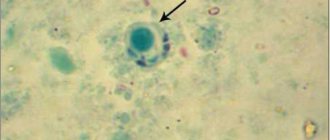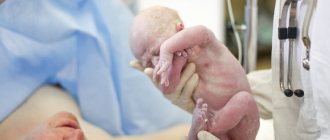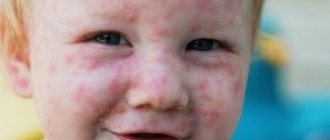Ascaris is a fairly large worm that is pale yellow in color and is the main causative agent of a disease called ascariasis. This most common parasite feeds only at the expense of the host’s body. Roundworms enter the human body through the fecal-oral route. Parasites live in the intestines in pairs, so their number is always even. The disease develops as a result of the introduction of mature eggs of the pathogen into the digestive tract through unwashed hands and food. In the small intestine, larvae emerge from them, penetrate the bloodstream and spread to all parts of the body.
Parasite Information
Roundworms belong to the family of roundworms. The length of such a helminth rarely exceeds 40 cm in females, and 25 cm in males. The causative agents of ascariasis can live in the host's body for 1-2 years. Then they die and leave the human body, excreted in the feces. Female roundworms are capable of laying about 200 thousand eggs per day, which are also released in feces. Most often, adult worms can be found in the small intestine area - this is their favorite place to live.
Both people and animals suffer equally from the manifestations of ascariasis. The human roundworm, through its vital activity, can provoke serious disorders in the body of the host. Parasites cause acute intestinal obstruction, can damage the integrity of the mucous membrane of its walls, and provoke pathologies of the pancreas or liver.
Worms are able to move throughout all organs of the digestive tract, but sometimes they even get into the organs of the respiratory system. As a result of such a lesion, a person may develop bronchitis, focal pneumonia, perforated peritonitis, hemoptysis and a feeling of suffocation may occur. Adult roundworms are sometimes found in the nasolacrimal canal, frontal sinuses, eustachian tubes and middle ear, appendix, urinary organs, and in the outer ear canal. The parasite secretes substances that can trigger allergies. In such a case, the patient experiences attacks similar to bronchial asthma, and skin rashes that resemble urticaria are possible. The constant residence of worms in the cavity of the small intestine causes inflammatory processes.
How to remove roundworm from the body?
Due to the widespread distribution of these parasites and their danger to humans, doctors are faced with the question of timely diagnosis of helminths and their removal. Classical therapy involves deworming with chemicals, but they cannot be taken in long courses. As a result, the chemicals only affect adult worms, while the roundworm larvae, which are no less dangerous to humans, remain viable.
Effective deworming must be comprehensive. Antiparasitic drugs from NPK Optisalt, created exclusively from natural ingredients, can be taken in long courses, the duration of which is sufficient to remove from the body not only adult roundworms, but also their larvae, as well as eggs. In addition, the Optisalt complex eliminates the harm caused to the human body by helminthic infestation: it removes waste products of the worm, improves the functioning of the gastrointestinal tract, and replenishes reserves of microelements. You can read in detail about how and how to treat roundworms in our article about ascariasis, published on the website.
Routes of infection
The structure of roundworms is such that their eggs survive in the environment even under the most unfavorable and harsh conditions. So, on fresh vegetables, products and fruits, in fresh soil and in water, they can exist for 6-7 years. They penetrate the gastrointestinal tract with unwashed food and hands, as well as with dirty water.
In favorable conditions of the host organism, larvae emerge from the eggs, which are carried through the bloodstream into the liver, pulmonary vessels and even into the heart cavity. Moving from the pulmonary alveoli to the bronchioles, they provoke irritation of the mucous membrane. The infected person coughs, as a result of which the larvae re-enter the mouth and are swallowed. This ends the development cycle of this helminth, and then adult roundworms inhabit the intestines.
This worm only affects the human body, so people become infected with ascariasis from each other if basic hygiene rules are not followed. Ascaris eggs released by the patient's body may be found in a favorable environment:
- on products;
- on unwashed vegetables and fruits;
- in contaminated water;
- on unwashed hands;
- on clothes, various household items or dishes.
The transfer of mature eggs of these helminths is also carried out with the help of ordinary flies, which are most active in the spring-autumn period.
Structural features
Like many parasites, roundworms have a fairly simple structure; the reproductive system is most developed, which explains the large number of eggs produced by the worm. Roundworm respiration is anaerobic; energy is produced through the breakdown of glycogen. The digestive system is well developed: the roundworm has a mouth opening, thanks to which it swallows food that enters the intestines.
The structure of the roundworm allows it to move freely in the gastrointestinal tract and cavities of the human body, while with minor invasion the patient may not even be aware of the presence of parasites. It is not uncommon for roundworms to be discovered in children only a year after the invasion: when the worm dies naturally.
At-risk groups
By eating unwashed vegetables or fruits, and even simply taking a clean apple with dirty hands, a person can introduce parasite eggs into his own body. After entering an environment favorable for the worm to live in, it quickly grows and multiplies - this is how ascariasis develops. The following categories of people most often suffer from this disease:
- children under 6 years of age (can become infected when visiting a kindergarten, where the risk of transmitting helminthiasis from one child to another is so high);
- plumbers;
- personnel of wastewater and sewerage treatment plants;
- agricultural workers;
- Gardeners also often get sick.
Nervous system
Its structure is also primitive. The nervous system of the parasite consists of one ganglion node represented by a peripharyngeal ring. It is located in the head part of the helminth. Dorsal and abdominal nerve bundles extend from it along the body. Their functions include organizing muscular control during movement and the presence of sensitivity.
Roundworms have practically no receptors. There are only papillomas, which are tactile bumps. They are located near the oral cavity.
Parasites also have no other sensitive formations. They have atrophied because the digestive environment of the human intestine does not contain any physical irritants.
Symptomatic signs of ascariasis
The clinical picture when the body is affected by roundworms will largely depend on the age of the patient, the extent of inflammatory damage to the small intestine and the degree of development of the pathology itself. The first stage of the disease often occurs without obvious symptoms. The migration phase of mature worm larvae is especially easy.
The most characteristic signs of ascariasis are:
- intoxication of the body - manifested by severe sweating, increased temperature, and a feeling of weakness;
- allergic syndrome - a rash appears on the surface of the body and limbs, severe itching appears in these areas of the body;
- liver factor - with this type of helminthiasis, the volume of the liver and spleen increases sharply, painful sensations in the area of the right hypochondrium are possible;
- respiratory disorders - a patient with ascariasis almost always has a dry or wet cough, pain in the lungs and shortness of breath.
Additional symptoms of this disease in adults and children during the stage of active reproduction of the pathogen can be: nausea with vomiting, lack of appetite, intestinal pain, diarrhea, convulsions, bloating, and a sharp decrease in body weight.
Digestion
You may be interested in: Zirconium bracelet: medicinal properties, benefits and harms, reviews
The digestive system of the human roundworm consists of a hollow tube that forms an intestine with four sections. Two of them are formed from ectoderm and two are of endodermal origin.
The intestine is a closed and tortuous cavity, which is located in the central part and passes through the entire body of the helminth. All nutrients are absorbed in the midgut.
Such a simple anatomy of the digestive system of the human roundworm is due to the fact that the parasite is constantly surrounded by food mass processed by the human intestine. This greatly simplifies the feeding mechanism for him.
The process of absorption of food occurs through the opening of the mouth, surrounded by the so-called lips.
Therapeutic measures
When roundworm is detected in the human body, treatment usually involves taking anthelmintic medications: Mebendazole, Albendazole or Ivermectin.
Albendazole for oral administration is usually prescribed in an amount of 400 mg per day. The use of Mebendazole can be divided into 2 times a day, 100 mg at a time, or a one-time dose of 500 mg, therapy continues for 3 days. The dosage of Ivermectin is calculated based on the patient’s weight at 150 or 200 mcg per kilogram. It should be mentioned that these medications are dangerous to take during pregnancy, so the risk of their use during this period must be justified by the indications.
Nitazoxanide shows good results in the treatment of mild to moderate ascariasis. The previously used drug Piperazine, due to its toxicity, has now been replaced by more advanced analogues.
In case of intestinal obstruction by adult helminths, in addition to anthelmintic drugs, surgical intervention to remove the worms may be required.
Epithelial cover and muscles
The epithelial cells of the human roundworm form the outer multilayered cuticle, also called the hypodermis. It consists of ten layers. It is the hypodermis that produces a substance that prevents the digestion of helminths by intestinal enzymes. On a cross-section of the helminth, it looks like a thin-walled shell covering it entirely.
The peculiarity of the hypodermis is that, despite its strength, it is very flexible. This allows the roundworm to actively move. There are four ridges on the cuticle. They are located on the sides, on the back and peritoneum. The ridges contain excretory organs that have the shape of canals. Each of them is a depression separating the hypodermis and the muscular frame.
Muscle consists of longitudinal fibers. These fibers, together with the epithelium, make up the lining of the body cavity of the roundworm and form the body wall.
This feature of the integument facilitates the active movement of parasites, but the muscular frame, which differs from the frames of other roundworms, does not allow them to move in a straight line.
Is it possible to become infected with worms from cats?
When interacting with soil, sand, grass and other animals, cats can become carriers of human roundworm eggs. They will pass to a person through direct contact with the cat. A person, having played with a cat or simply stroked it, has no idea that the pet has “rewarded” him with parasite eggs.
Prevention is to wash your hands after every contact with cats. But often people forget about the importance of this procedure. Therefore, infection with helminths from cats occurs quite often.
Brain damage
When roundworm parasitizes the brain, the manifestations of infection may change. Their character depends on which part of the brain the helminths are localized in. So, if the habitat of roundworms is the outer meninges, then a person develops meningoencephalitis. It will be accompanied by the following clinical manifestations:
- feeling of unbearable pain in the head;
- spasms of the neck muscles;
- noise in the head;
- dizziness.
If roundworms are located deep in the grooves of the medulla, then there is a risk of developing disorders that are observed during a stroke.
When parasites are localized in areas responsible for visual and auditory perception, disturbances may occur.
If roundworms are in the brain, the question may arise as to how they get there. The entry of helminths into this vital organ can occur in several ways.
- In the first case, everything is simple: a significant number of helminth larvae move throughout the body with the bloodstream, and given the fact that there are no valves in the veins of the brain, it is not difficult for them to get into it. Having penetrated the nervous tissue, the larvae develop, grow and live in it for a long time.
- In the second case, penetration of the larvae can occur through the nasopharynx and nasal sinuses. When located in these areas, mental and visual functions are impaired.
- As for the third route of penetration, it occurs due to the movement of the larvae through the middle ear to the inner ear. Already from this area, parasites penetrate the brain through the pyramids of the temporal bones, as a result of which the brain tissue becomes their habitat. In such an environment, the helminth has the opportunity to live for a year. If his death occurs, this leads to the formation of severe intoxication of the entire body, and only timely qualified treatment will save the person.
Under the skin
Another localization of roundworms is the skin. Not everyone can believe this, but cases of ascaris migrating under the skin are increasingly being observed. This is a rather unpleasant location, because a person can observe the vital activity of the parasite. Typically, penetration into this area occurs when roundworms are distributed throughout the body, so they are looking for new places of existence.
The worm located under the skin looks like a rope, which has a convoluted appearance, while it rises above the skin. In addition, swelling and a bright red color of the affected area are observed. Also, when touched, pain and severe itching occur. Therefore, the location of the lesion is quite easy to notice.
Typically, the treatment of roundworms involves both medication and surgery. Medicines remove parasites from the body, and surgery removes them surgically. If treatment is not started in time, the infected person may experience a fever and deterioration in general condition. Particular attention should be paid to the child’s health in this regard.
Diagnostics
Modern laboratory tests accurately determine the type of parasite.
Blood test for antibodies When starting a diagnosis, one must take into account that it is much more difficult to detect larvae in the migration stage. Differential analysis will be very important in such cases. After the research, the difference between ascariasis and other helminth infections will be obvious. Several types of research are carried out:
- hematological;
- immunological;
- X-ray.
During diagnosis, migrating roundworm larvae are detected during lung sputum tests. A blood test shows the presence of eosinophils, and an eosinophilic infiltrate is detected in the respiratory organs. Often the diagnosis is based on the analysis of stool, which contains eggs of human roundworms. The most reliable method is considered to be vegetative resonance diagnostics, with the help of which the specific type of helminth and the place where it parasitizes is determined.
A parasitic infection caused by roundworms can be completely cured without complications or consequences for human health.
Bibliography
- Centers for Disease Control and Prevention. Brucellosis. Parasites. Link
- Corbel MJ Parasitic diseases // World Health Organization. Link
- Young EJ Best matches for intestinal parasites // Clinical Infectious Diseases. — 1995. Vol. 21. - P. 283-290. Link
- Yushchuk N.D., Vengerov Yu.A. Infectious diseases: textbook. — 2nd edition. - M.: Medicine, 2003. - 544 p.
- Prevalence of parasitic diseases among the population, 2009 / Kokolova L. M., Reshetnikov A. D., Platonov T. A., Verkhovtseva L. A.
- Helminths of domestic carnivores of the Voronezh region, 2011 / Nikulin P. I., Romashov B. V.
An article for patients with a doctor-diagnosed disease. Does not replace a doctor's appointment and cannot be used for self-diagnosis.
The best stories from our readers
Topic: Parasites are to blame for all troubles!
From: Lyudmila S. ()
To: Administration Noparasites.ru
Not long ago my health condition worsened. I began to feel constant fatigue, headaches, laziness and some kind of endless apathy appeared. Problems also appeared with the gastrointestinal tract: bloating, diarrhea, pain and bad breath.
I thought it was because of the hard work and hoped that it would go away on its own. But every day I felt worse. The doctors couldn’t really say anything either. Everything seems to be normal, but I feel like my body is not healthy.
I decided to go to a private clinic. Here I was advised, in addition to general tests, to get tested for parasites. So in one of the tests they found parasites in me. According to doctors, these were worms, which 90% of people have and almost everyone is infected, to a greater or lesser extent.
I was prescribed a course of antiparasitic medications. But it didn’t give me any results. A week later, a friend sent me a link to an article where some parasitologist shared real tips on fighting parasites. This article literally saved my life. I followed all the advice that was there and after a couple of days I felt much better!
Digestion improved, headaches went away and the vital energy that I so lacked appeared. To be sure, I took the tests again and no parasites were found!
Anyone who wants to cleanse their body of parasites, no matter what types of these creatures live in you, read this article, I’m 100% sure it will help you! Go to article>>>
Still have questions? Ask them in our Anonymous group on VK
How to get rid of parasites in a week. The answer is here!
A reliable and effective remedy for combating worms. Removes all parasites in 21 days.
Go to website
Reviews
Read online
Symptoms that 100% indicate parasites! Take the Test.
How to rid your body of life-threatening parasites before it’s too late!
Read more
Website
To get a consultation
The doctor tells how to quickly get rid of parasites for adults and children!
A parasitologist explains what effective methods exist to combat helminths.
More details
Read completely
Comments
Search for cures for parasites
This service is a small help in finding cures for parasites. To start using it, select the type of parasite. If you don’t know what kind of parasite you are infected with, this parasite identification tool will help you by symptoms.
We recommend reading
The importance of parasites in nature: the role of parasitic worms, fungi and bacteria
01/27/202102/02/2021ecoliv94
Will there be worms if you bite your nails? Why you shouldn't bite your nails
01/25/202102/3/2021ecoliv94
Where do parasites (worms, fungi, bacteria) live in the human body?
01/08/202112/01/2021ecoliv94
Where do pinworms live in the human body, symptoms and treatment
01/08/202112/01/2021ecoliv94
In eyes
The most unusual and rare location of roundworms is the eyes. But parasites very rarely get there, because the eyes are far from their usual habitat - the intestines. However, such cases have been recorded and studied. Usually a parasite that has crawled into the eye is looking for new places to live, especially if there are large colonies that occupy all human organs.
When such a worm gets into the eye, the choroid first suffers from its parasitism, because it is well suited for its habitat. This lesion immediately causes pathological processes such as panuveitis, chorioretinitis and optic neuritis. Very often the defeat is accompanied by:
- swelling of the eyelids;
- conjunctivitis;
- dilation of blood vessels in the iris;
- corneal keratitis;
- retinal hemorrhage.
If roundworms are detected in the eyes, the doctor may prescribe treatment, which consists of taking anthelmintic drugs and using topical drops. They will create unfavorable conditions for the existence of parasites.
And although eye damage is rare in medical practice, it still requires special attention. If treatment is not carried out in a timely manner, this may affect vision. The parasite by itself does not immigrate to another organ, because the mucous membrane of the eye has all the necessary conditions for its life and development.
Re-infection
Since the human body does not develop the necessary defenses to prevent infection, a person who has once had ascariasis can be re-infected.
Despite this, the use of medications for ascariasis for preventive purposes is not recommended. The reason for this is the drugs themselves. Ascariasis is treated with very powerful drugs. And preventative medications do not provide the desired result. The worms will not die from them and will not be eliminated naturally, but will begin to climb up the intestines. The consequence may be the release of parasites through the mouth, nose and ears, which causes significant discomfort to the patient.
Source










